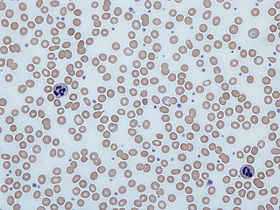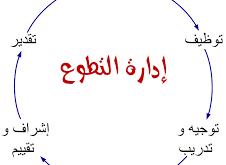Anemia
weakness,
shortness of breath or a poor ability to exercise.
Anemia that comes on quickly often has greater symptoms which may include: confusion,
feeling like one is going to pass out,
and an increased desire to drink fluids.
There needs to be significant anemia before a person becomes noticeably pale.
There may be additional symptoms depending on the underlying cause.[4]
There are three main types of anemia,
that due to blood loss,
that due to decreased red blood cell production,
and that due to increased red blood cell breakdown.
Causes of blood loss include trauma and gastrointestinal bleeding among others.
Causes of decreased production include iron deficiency,
a lack of vitamin B12,
thalassemia and a number of neoplasms of the bone marrow among others.
Causes of increased breakdown include a number of genetic conditions such as sickle cell anemia,
infections likemalaria and some autoimmune diseases among others.
It can also be classified based on the size of red blood cells and amount of hemoglobin in each cell.
If the cells are small it is microcytic anemia,
if they are large it ismacrocytic anemia and if they are normal sized it is normocytic anemia.
Diagnosis in men is based on a hemoglobin of less than 130 to 140 g/L (13 to 14 g/dL) while in women it must be less 120 to 130 g/L (12 to 13 g/dL).[4][5] Further testing is then required to determine the cause.[4]
Certain groups of individuals,
such as pregnant women,
benefit from the use of iron pills for prevention.[4][6] Dietary supplementation,
without determining the specific cause,
is not recommended.
The use of blood transfusions is typically based on a persons signs and symptoms.[4] In those without symptoms they are not recommended unless hemoglobin levels are less than 60 to 80 g/L (6 to 8 g/dL).[4][7] These recommendations may also apply to some people with acute bleeding.[4] Erythropoiesis-stimulating medications are only recommended in those with severe anemia.[7]
Anemia is the most common disorder of the blood with it affecting about a quarter of people globally.[4] Iron-deficiency anemia affects nearly 1 billion.[8] It is more common in females than males[8] among children,
during pregnancy and in the elderly.[4] Anemia increases costs of medical care and lowers a person’s productivity through a decreased ability to work.[5] The name is derived from Ancient Greek: ἀναιμία anaimia,
meaning “lack of blood”,
from ἀν- an-,
“not” + αἷμαhaima,
“blood”.[9]
- بحث عن الانيميا بالانجليزي
- بحث عن الأنيميا بالانجليزي
- بحث عن الانيميا باللغه الانجليزيه
- بحث باللغة الإنجليزيه عن مرض الربوpdf
- تقرير كامل عن مرض الأنيميا باللغةالانجليزية












